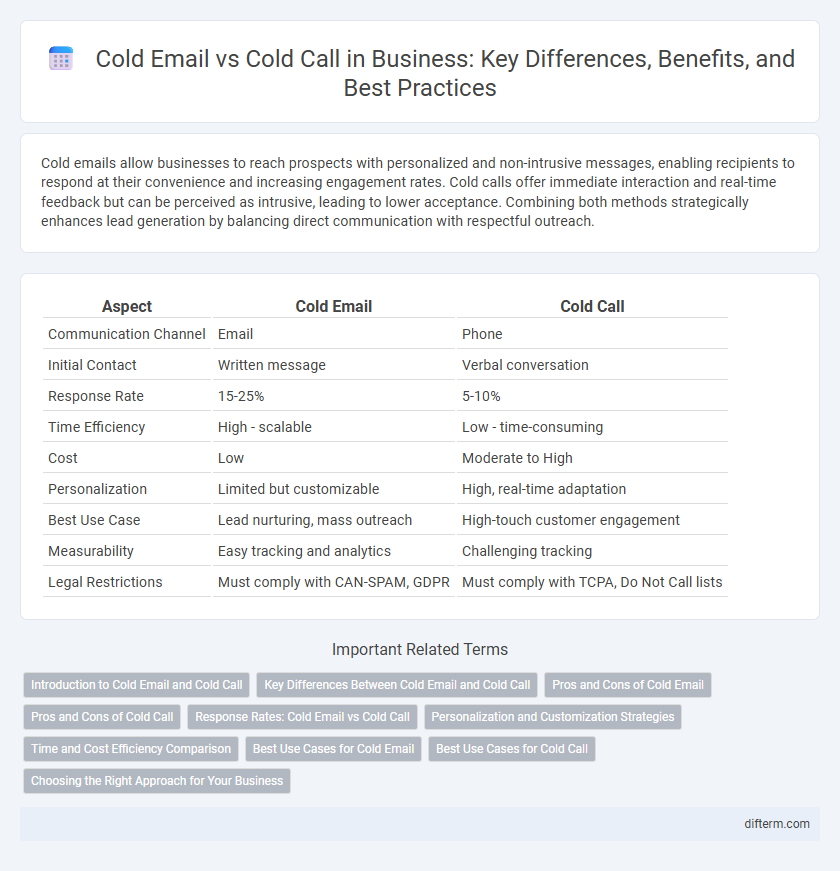Cold emails allow businesses to reach prospects with personalized and non-intrusive messages, enabling recipients to respond at their convenience and increasing engagement rates. Cold calls offer immediate interaction and real-time feedback but can be perceived as intrusive, leading to lower acceptance. Combining both methods strategically enhances lead generation by balancing direct communication with respectful outreach.
Table of Comparison
| Aspect | Cold Email | Cold Call |
|---|---|---|
| Communication Channel | Phone | |
| Initial Contact | Written message | Verbal conversation |
| Response Rate | 15-25% | 5-10% |
| Time Efficiency | High - scalable | Low - time-consuming |
| Cost | Low | Moderate to High |
| Personalization | Limited but customizable | High, real-time adaptation |
| Best Use Case | Lead nurturing, mass outreach | High-touch customer engagement |
| Measurability | Easy tracking and analytics | Challenging tracking |
| Legal Restrictions | Must comply with CAN-SPAM, GDPR | Must comply with TCPA, Do Not Call lists |
Introduction to Cold Email and Cold Call
Cold email and cold call are two key outreach strategies used in business to initiate contact with potential clients or customers. Cold email involves sending unsolicited messages via email to introduce a product or service, offering a non-intrusive way to engage prospects with personalized content and clear calls to action. Cold call refers to making unsolicited telephone calls to potential clients, allowing for immediate interaction and real-time feedback but often requiring strong communication skills to overcome initial resistance.
Key Differences Between Cold Email and Cold Call
Cold email leverages written communication allowing for scalability, detailed information sharing, and asynchronous follow-up, while cold calls provide immediate interaction, personalized engagement, and real-time objection handling. Email campaigns offer measurable metrics like open and click-through rates, enabling data-driven optimization, whereas cold calls rely on conversational cues and adaptability to gauge prospect interest. Understanding these distinctions helps businesses tailor outreach strategies to target audience preferences and increase conversion rates.
Pros and Cons of Cold Email
Cold email enables scalable outreach with precise targeting, allowing businesses to craft personalized messages and track engagement through analytics. It offers cost-effective communication without the intrusiveness of a phone call, increasing the likelihood of recipient response during flexible timeframes. However, cold email faces challenges like low open rates, spam filters, and delayed responses, which can hinder immediate follow-up and relationship building compared to real-time conversations in cold calls.
Pros and Cons of Cold Call
Cold calls enable real-time interaction, allowing immediate feedback and personalized responses, which enhances relationship building and quick decision-making. However, they can be intrusive, often leading to negative reception and lower contact rates due to gatekeepers and call screening. The direct verbal communication can drive higher conversion rates but requires skilled sales representatives to effectively handle objections and maintain engagement.
Response Rates: Cold Email vs Cold Call
Cold email response rates typically range between 15% to 25%, proving more effective for reaching larger audiences with personalized messaging. Cold calls average lower response rates, usually around 1% to 3%, due to gatekeepers and recipient resistance to unsolicited phone contacts. Businesses aiming for scalable outreach often prefer cold emails to optimize lead generation and engagement efficiency.
Personalization and Customization Strategies
Cold email allows for highly personalized and customized outreach through tailored subject lines, segmented content, and data-driven messaging that addresses specific recipient needs and pain points. Cold calls offer real-time interaction, enabling dynamic adjustment based on prospect responses and the opportunity to build rapport through tone and conversation flow. Integrating CRM insights and buyer personas enhances the effectiveness of both strategies by ensuring relevant, targeted communication that increases engagement and conversion rates.
Time and Cost Efficiency Comparison
Cold emails offer superior time and cost efficiency by enabling mass outreach with minimal expenditure and automated tracking, significantly reducing labor hours compared to cold calls. Cold calls demand more time per contact and incur higher costs due to staffing and phone infrastructure, limiting scalability for businesses targeting large lead volumes. Companies often achieve faster lead generation and lower customer acquisition costs through optimized cold email campaigns versus resource-intensive cold call strategies.
Best Use Cases for Cold Email
Cold email excels in B2B lead generation where decision-makers require detailed product information and prefer asynchronous communication, allowing recipients to consider offers at their convenience. It is highly effective for nurturing long-term relationships, sharing case studies, whitepapers, or personalized proposals tailored to specific industry pain points. Cold email campaigns benefit from automation tools, enabling scalable outreach to segmented lists while maintaining a professional and targeted approach.
Best Use Cases for Cold Call
Cold calls excel in establishing immediate, personal connections with prospects who require quick responses or have complex questions that need real-time clarification. They are particularly effective in B2B environments where decision-makers can be reached directly and when introducing high-value products or services requiring detailed explanations. Cold calls also perform well in industries with longer sales cycles, enabling dynamic conversations that build trust and rapport more effectively than cold emails.
Choosing the Right Approach for Your Business
Cold email enables scalable outreach with measurable open and response rates, making it ideal for data-driven businesses targeting niche markets. Cold call offers immediate, personalized engagement that fosters real-time dialogue and quick feedback, suited for high-touch sales requiring rapport building. Selecting the right approach depends on factors like target audience preference, sales cycle length, and resource availability to maximize conversion efficiency.
cold email vs cold call Infographic

 difterm.com
difterm.com